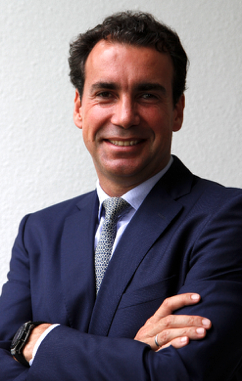Transcripts

Erik: Joining me now is Diego Parilla, CIO at Quadriga Asset Management. Diego, it's great to get you back on the show. It's been quite a while. Needless to say, I think what's on everybody's mind these days is okay, what exactly just happened? It was a yen carry trade unwind because of a BOJ policy decision. Oh, wait a minute. They changed their mind. They took it back. Does that mean it's all over? Is this just a correction now? Are we headed higher, or is this just the beginning of a bear market? What should we think about this big risk event that's just happened in the market, and Is it over yet?
Diego: Yeah, thanks Erik for having me back. And for sure, I think what happened is the result of a number of drivers. I mean, first of all, we've had a period of what I would consider to be artificially low levels of volatility, and that has contributed to a number of dynamics, including very successful in crowded carry trades across the board, where the Japanese yen happened to be one of the preferred but not the only funding currency. The other major factor, obviously, is what I would consider the bluff on Japan's idea that you can actually print and borrow your way out of problems at infinite and that bluff has been called. Japan's been leading the monitoring fiscal abuse for the past few decades with zero and negative nominal yields and extraordinarily high levels of government debt, basically driven by this view that the enemy is deflation, and you can literally print and borrow as much as you want without any severe consequences. And so, what's been playing out for the last couple of years, is a reversal of some of those dynamics, with effectively inflation post-COVID being obviously a clear problem. Countries and economies like the US aggressively hiking at a pace in size that had literally no precedents, and people like Japan lagging behind big time, totally unable and unwilling, but mostly unable to do something about it. And that widening rate differential that you know, inflation, that all these factors contributed to pretty much a one-way depreciating yen in a low vol. So, if you add the low volatility trend, wide carry and this spiral of the valuation that leads to dynamics that are effectively very difficult to revert. I think they got into a position that got to a bit of an extreme.
So the BOJ, I think Central Bank of Japan, they're back against the wall. They effectively took the decision to unwind yield curve control. For me, that was really a pretty major point in the fate of Japan, because effectively, with the level of debt that they have, to pretend they can let long term yields to go up somewhat freely is science fiction. It leads to a situation where, as these long-term yields, or yields in general, go up, and you have too much debt, they could result into what I call an LDI2. I mean, you might remember the crisis in the UK, where we had higher yields, weaker Sterling. And this situation got Japan to extreme levels in Dollar/Yen, which effectively forced intervention for the nth time, and were potentially opening the door to force repatriation, or the more extreme measures. I think, once you go into the hikes and the market starts pricing them out, and those actually materialize, I've seen some of these skeletons in the close that come out. Volatility increases, and there's a clear bubble, anti-bubble relationship here between volatility and prices and the CTAs. I think trend followers are big drivers of both moves on the way up and down, and the move in the Nikkei, it's somewhat a bit of a zero sum game in total return terms, because a lot of the strength that we saw in the Nikkei, that everybody felt very happy about, effectively reversing multi decade cycle and making new all-time highs was largely driven by Yen weakness, and so it shouldn't be a surprise that as the yen unwinds and strengthens, then you have this dynamic in the Nikkei.
So, to keep things equal, 20% down move in Dollar/Yen and a 20% up move in the Nikkei, or vice versa, lead to effectively neutral total return game. So I think that all that went to expose that, obviously, the central bank had to step in refrain, or control a little bit some of those expectations with hikes. Because I think what we're seeing is the reaffirmation of the big thesis of the anti-bubble. You know, if you abuse monitoring fiscal policies, eventually the degree of freedom is inflation and the currency. And in some ways, what we've seen is, as Mike Tyson would say, everybody has a plan until they punch you in the face. And I think once you see your currency moving, but worse than that, you see your equity market collapsing and doing 12.5% in a day, worst day since ‘87 and a 20% drawdown in a few days, then obviously forces people to react. So my sense is, implied volatility is picked up. It's still at reasonably high levels. We're off the highs, but still high. But if you look at the VIX and other markets, that's already easing fast. So, my sense is that the carry trade is very much alive. The position has been cleaned significantly. Depending on who you ask, you might hear that that's been reduced to about by 75% and so my sense is Dollar/Yen is going to go back up with a weaker Yen as volatility consolidates in some of these dynamics that we've discussed with rate differentials and others, and inflation and continue to play out. So, I think this is a bit of a canary in a coal mine, you get, again, every time you have artificially low volatility in artificially high prices, or vice versa, they can last for a while. They create a lot of complacency, but when they unwind, they can do it in a very fast and vicious way, which is what we've witnessed. And you know, I think whilst the position is now much cleaner, and probably will see that some of these moves going back to where we were before. There's a bit more caution and perhaps a few people licking their wounds. But yeah, I think the fundamental picture hasn't changed. The big framework has been reinforced. And yeah, there are a lot of structural issues in the system that we need to be mindful about.

Erik: Joining me now is Gavekal co-founder, Louis-Vincent Gave. Louis, any other guest but you, it's so easy to do an August interview. You talk to the guest off the air. It's like, okay, dog days of summer. Nothing happened in the market, nothing to talk about. Let's make something up. We don't have to do that this week, do we? And you know, when the VIX hit 60 on Monday, my first reaction was to look at the calendar, and I thought to myself, wait a minute, I'd have thought we didn't have Louis Gave until tomorrow, because it seems like every time you and I talk, something crazy happens in the market.
Louis: That's right. Thanks for having me on. It's always a pleasure to chat. You probably remember this, but you and I were taping an interview the day the WTI went negative. So with that in mind, I think what I'm going to start doing now is, each time I do a MacroVoices interview, maybe I'll start buying calls on the VIX and, you know, way, way, way out of the money calls and puts on a bunch of asset classes the week or two before we’re slated to talk, because it does seem that there's an uncanny coincidence where each time we're talking, things seem to be melting down.
Erik: Dude, I've already got plans to launch an ETF where basically the strategy is, we know we have inside information. Our producer knows when Louis Gave is on the schedule. We're buying structured, you know, hedge instruments, the Friday before we get you on the show, dude. Anyway…
Louis: It’s the only rational thing to do.

Erik: Joining me now is Commodity Context founder Rory Johnston. Rory, it's great to catch you back on the show. You know, when I saw you on the schedule, I thought I just talked to Rory a couple of weeks ago. It's been months since we've had you on now. Everything's changed, though I guess you and I had a completely incorrect understanding of where this whole OPEC thing was going, because it's just been announced by none other than President Trump's campaign, that what's going on here is OPEC is working as hard as they possibly can to suppress oil prices, because they want to get Kamala Harris elected. I know this is exactly what you've been commenting on in the data that you follow so closely. Maybe not. What's going on here? Is this just politics? And more importantly, what is the real situation with respect to OPEC’s intentions here? What is their real intention?
Rory: Yeah, so that's exactly right. And I think you and I exchanged briefly on Twitter about this. So the statement from former President Trump was essentially along the lines what you said, going all out to depress oil prices in order to help elect Democrats and specifically Kamala Harris, because the belief being that Kamala Harris would be somehow better for OPEC. I assume the reference here is to Kamala’s 2019 statement that she would ban US fracking, which I don't think will ever happen. But again, I mean, it's useful, it's an election year, truth is kind of, and reality is secondary. But I think it's important, and I thank former President Trump for this hook. Because I'm writing a piece right now on really kind of disentangling the true extent of how much OPEC is actually supporting the market. It's important to note that while, we'll get to a second about, the current weakness in the market and what we're seeing, but most forecasters, whether it's the EIA, IEA, OPEC, or a whole bunch of different private sector forecasters, all generally expect that as OPEC extended its production cuts into the third quarter of 2024, that we're going to see a net deficit continued strength, at least in a fundamental basis in the oil market from that. But relative to what Trump was saying about going all out to produce and depress the price of oil, OPEC is doing the exact opposite. It's going all out to support the price of oil, excluding the COVID era cuts because I think those are a special case, but excluding COVID. The current amount of supply that OPEC is withholding from the market roughly 4 million barrels a day of realized tangible cuts relative to October 2022 levels when this new cutting cycle restarted again. That's the most crude that OPEC and OPEC+ is withholding from the market since the 2008/2009 financial crisis. These are crisis level production cuts and market supports. At a time when last year, demand grew by more than 2 million barrels a day. In any other year, this would be considered a strong year for oil markets. The only difference is that OPEC is supporting us multiple, you know $10, $20, $30, $40 higher than we were if OPEC was to completely release, but open the floodgates and release all the crude to the market, we would probably be sub $50 Brent. That's a lot of oil that's being withheld from the market. And I think, while I do not think that OPEC will release that all at once, I think obviously, OPEC, more than anyone else, wants high oil prices. The longer they hold these cuts back the longer they maintain this crisis level support for the market, the weaker discipline and kind of cohesion across OPEC+ becomes, and I think that is just a time series. You know, the longer you go on holding these cuts, the higher the probability that the whole agreement breaks down and the ultimate bearish scenario of all this crude coming back to the market comes all at once.
But if we're just looking at a base case, and that's not my base case, I should be very, very clear. We're looking at a base case, OPEC has said that it's going to start easing the latest tranche, about 2.2 million barrels of oil to 22 million barrels a day of production cuts back into the market beginning in October and extending a year forward into 2025. But if you look at most of the forecasts from the major agencies, IEA, EIA and OPEC itself, most of those agencies really don't seem to indicate that there's going to be enough room in the market to eat all those production cuts back without tanking the price. Now, Saudi oil minister Abdulaziz bin Salman has said that that plan is market dependent and I believe him on this. I think that it's unlikely that OPEC is going to go ahead with a full production cut easing, I think at best, they're going to do half and probably even less than that. But I think we're going to need to wait to see where we are, come October, to see when and how exactly they stickhandle the messaging around pushing that back. Because I think it's even more important than the message, the market is seeing the message to the membership because the reason that they had announced that cut easing was that they were trying to placate members, particularly the United Arab Emirates, which has been promised continually that they're going to be allowed to produce more just one day, just around the corner and so far, we haven't seen that

Erik: Joining me now is Marko Papic, Chief Strategist for BCA Research. Marko is a geopolitical specialist. And we're going to be talking about the US presidential race, the unexpected turns that it's taken, and what the consequences and impacts of that are going to be knock-on effects for that matter, on the US presidential election and beyond. Now, occasionally, we get arguments and complaints from people who say, you shouldn't talk about politics on an investing podcast. Look, this is MacroVoices, macro means macro-economic events, politics are among them. If you don't like hearing about politics on an investing podcast, don't listen to a macro investing podcast, look at one that uses a different strategy. If you are offended by the fact that we're going to have a very candid conversation about risk factors, other things that could go wrong, and other terms that this race could take, then skip ahead now to the postgame segment and dive into the chart deck with Patrick Ceresna.
Marko, let's start with a situation report. As of now, Tuesday morning, we're recording this a couple of days before our audience will hear it and a lot can happen at the rate the news flow has been coming out in the last few days. But as of the moment that we're speaking Tuesday morning, the President of the United States has not been seen in public for six days since last Wednesday, he was diagnosed with COVID. And it was announced or leaked, I should say, that people should expect an announcement over the weekend that maybe he would be dropping out of the presidential race. That announcement or that leak was very promptly refuted by the White House, which said, no, President Biden is absolutely positively not dropping out of the race. He's in it. He's staying in it. I think it was on Thursday, when President Biden himself said, look, it would take an act of God, nothing short of the Lord Almighty himself telling me to step out of the race would get me out of it now. Then over the weekend, there was no presidential address from the Oval Office, there was no Joe Biden on camera. There was a tweet from Joe Biden's Twitter account that said, Dear United States, I've decided that it's in the best interest of the party and the country for me to leave the presidential race, no explanation of why he was doing that, other than he's decided it was in the interest of the party. At this point, there were people, understandably, that everybody is going to wild speculation on conspiracy theories. The president's dead, the President's been abducted, the President's locked up in a basement being waterboarded. by Nancy Pelosi. I mean, every crazy imaginable thing has been suggested.
Marko, I don't think it's responsible for us to get into believing the conspiracy theories. But I think we should acknowledge that it's very understandable that people are jumping to them, when we've had such poorly managed communications. The last time this happened was 1968, Lyndon B. Johnson, dropping out of the race late, made and addressed to the people on television, so that his reason for doing that and so that the American people could be assured as he was dropping out of the race that he was doing so of his own volition. That's not happening here. And a lot of people are very concerned by it. They have scheduled an address from the President to the public on Wednesday. That hasn't happened yet. As we're recording, it will have happened by the time our listeners hear it, whether it's going to be live or on video or pre-recorded, hasn't been specified yet. What's going on here, Marko, this is not normal operations for the United States of America.
Marko: Well, first of all, thank you for having me on the show. I don't know if I can answer this question. I don't think anyone can really answer the question. I think the election process has always been a little bit of a wild west. And part of it is because in the United States of America, there isn't actually any constitutional provision. There isn't any real law for how parties select their leaders. In fact, almost every four years, they issue new rules and regulations, which parties go first, which goes second, there's state law on running primaries, on running, like local elections. And so, it's a mess. And it's exacerbated by the fact that President Biden has COVID and he is 81 years old. He was born in November of 1942. First of all, that means he was a voting adult, when LBJ quit the election in 1968, if you sort of want to think about it that way. But the other issue is that it probably reveals his vulnerabilities to being a candidate in this election, because getting COVID in 2024, for most of us is not a big deal, but for him it may really be. And that may be the reason that they're taking it a little bit more cautiously in terms of him speaking to the public.

Erik: Joining me now is Lyn Alden, founder of Lyn Alden Investment Strategy. Lyn, it's great to get you back on. It's been so long. Lyn, let's start with what you've been writing about this week, which is the way the market has been conditioned to rate hikes and rate cuts. What's your outlook?
Lyn: Right. So in the past cycle, we have kind of seen firsthand that the economy was more resilient to rate hikes than many would have expected. Basically, with the federal government having fairly short duration debt and most parts of the private sector having pretty long duration debt that's fixed, the economy was relatively resilient. As rate hikes occurred, the deficits got way larger, which in some cases, can be stimulatory for the industries that are on the receiving side of the deficits, and all that interest expense. And mortgages and corporate debt, a lot of that was shielded from that higher rate for quite a while. And so, one of the things I've been analyzing is to determine if that's going to be the case on the other side of this as well, if the US economy is going to be more desensitized to rate cuts than it normally has been in relative to other countries. So, from an American perspective, not a lot of Americans realize in other countries, homeowners, for example, are less likely to have, there's like a lower ratio of fixed rate, long duration debt, tied to housing in other countries. And so, they can be more sensitive to industry, it's on the up or down cycle. And so, this was kind of a perfect storm for the US being more resilient against rate hikes. And I think we can see the other side of this on the cutting cycle.
MACRO VOICES is presented for informational and entertainment purposes only. The information presented in MACRO VOICES should NOT be construed as investment advice. Always consult a licensed investment professional before making important investment decisions. The opinions expressed on MACRO VOICES are those of the participants. MACRO VOICES, its producers, and hosts Erik Townsend and Patrick Ceresna shall NOT be liable for losses resulting from investment decisions based on information or viewpoints presented on MACRO VOICES.
